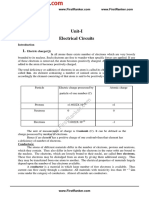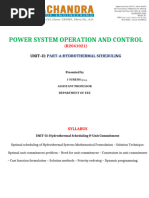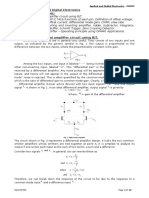Initial and Final Value Theorems
Uploaded by
Soumya BhattacharyaInitial and Final Value Theorems
Uploaded by
Soumya BhattacharyaInitial and Final Value Theorems
A right sided signal's initial value
value
transform
and final
(if finite) can be found from its Laplace
by the following theorems:
Initial value theorem:
Final value theorem:
Proof: As
When
for
, we have
, the above equation becomes
i.e.,
When
, we have
i.e.,
However, whether a given function
locations of the poles of its transform
has a final value or not depends on the
. Consider the following cases:
If there are poles on the right side of the S-plane,
will contain
exponentially growing terms and therefore is not bounded,
exist.
does not
If there are pairs of complex conjugate poles on the imaginary axis,
will contain sinusoidal components and
is not defined.
If there are poles on the left side of the S-plane,
will contain
exponentially decaying terms without contribution to the final value.
Only when there are poles at the origin of the S-plane,
will contain
constant (DC) component which is the final value, the steady state of the
signal.
Based on the above observation, the final value theorem can also be obtained by
taking the partial fraction expansion of the given transform
where
are the poles, and
time domain:
by assumption. The corresponding signal in
All terms except the first one represent exponentially decaying/growing or
sinusoidal components of the signal. Multiplying both sides of the equation
for
by
and letting
, we get:
We see that all terms become zero, except the first term
. If all
poles
are on the left side of the S-plane, their corresponding
signal components in time domain will decay to zero, leaving only the first
term
, the final value
Example 1:
First find
When
, we get
. Next we apply the final value theorem:
Example 2:
According to the final value theorem, we have
However, as the inverse Laplace transform
is unbounded (the first term grows exponentially), final value does not exist.
The final value theorem can also be used to find the DC gain of the system, the
ratio between the output and input in steady state when all transient components
have decayed. We assume the input is a unit step function
, and find
the final value, the steady state of the output, as the DC gain of the system:
Example 3:
The DC gain at the steady state when
can be found as
You might also like
- Canon - Elura 10A, 20MCA - Service ManualNo ratings yetCanon - Elura 10A, 20MCA - Service Manual177 pages
- EFFECTS OF ADDITION OF POLES AND ZEROS IN ROOT LOCUS SPNo ratings yetEFFECTS OF ADDITION OF POLES AND ZEROS IN ROOT LOCUS SP6 pages
- 3rd - SEM - ECA - VS - Unit - 3rd - Part 1No ratings yet3rd - SEM - ECA - VS - Unit - 3rd - Part 184 pages
- Spontaneity: Decrease in The Enthalpy A Criterion For Spontaneity ?No ratings yetSpontaneity: Decrease in The Enthalpy A Criterion For Spontaneity ?11 pages
- Chapter 2 - Basic Concepts of ModulationNo ratings yetChapter 2 - Basic Concepts of Modulation25 pages
- Signal Conditioning - Explanation and Block Diagram of DC - AC System (16 Marks)No ratings yetSignal Conditioning - Explanation and Block Diagram of DC - AC System (16 Marks)4 pages
- Square Wave Generator Using Op Amp - WaveformsNo ratings yetSquare Wave Generator Using Op Amp - Waveforms5 pages
- UNIT-III-T. Veerarajan Complex Differentiation100% (1)UNIT-III-T. Veerarajan Complex Differentiation100 pages
- Circuit Diagram:: Experiment No: 1 Title: Calibration of A Milliammeter As A Voltmeter. Objectives50% (2)Circuit Diagram:: Experiment No: 1 Title: Calibration of A Milliammeter As A Voltmeter. Objectives2 pages
- Conversion of Biomass: Presented By-Gurpreet Singh L-2K16-AE - 178-MNo ratings yetConversion of Biomass: Presented By-Gurpreet Singh L-2K16-AE - 178-M86 pages
- Steady State Analysis of AC Circuits: Chapter-IVNo ratings yetSteady State Analysis of AC Circuits: Chapter-IV15 pages
- Single and Three Phase Wattmeter and Energy MetersNo ratings yetSingle and Three Phase Wattmeter and Energy Meters29 pages
- JNTUA JNTUH JNTBasic Electrical and Electronics Engineering BEEE NoteNo ratings yetJNTUA JNTUH JNTBasic Electrical and Electronics Engineering BEEE Note93 pages
- 15MA102 Advanced Calculus and Complex Analysis PDFNo ratings yet15MA102 Advanced Calculus and Complex Analysis PDF2 pages
- 2.07 Ripple Factor, PIV, TUF, Form Factor, Peak Factor100% (2)2.07 Ripple Factor, PIV, TUF, Form Factor, Peak Factor1 page
- PDF Pdfsecretcomcourse in Electrical Power J B Gupta PdfsdocumentscompdfNo ratings yetPDF Pdfsecretcomcourse in Electrical Power J B Gupta Pdfsdocumentscompdf2 pages
- Signals and Systems: 2 Mark Questions and Answers 1.define SignalNo ratings yetSignals and Systems: 2 Mark Questions and Answers 1.define Signal24 pages
- Difference Between Enhancement Type and Depletion Type MOSFETNo ratings yetDifference Between Enhancement Type and Depletion Type MOSFET3 pages
- 1-Third Harmonic Injection PWM Technique For Maximizing DC-BUS Utilization of Five-Phase VSIsNo ratings yet1-Third Harmonic Injection PWM Technique For Maximizing DC-BUS Utilization of Five-Phase VSIs10 pages
- Lab # 01 To Study The Transient Response of RL Series Circuit Materials100% (1)Lab # 01 To Study The Transient Response of RL Series Circuit Materials4 pages
- 5V Power Supply Using 7805 Voltage Regulator100% (1)5V Power Supply Using 7805 Voltage Regulator3 pages
- RRB Admit Card Previous Year Question Papers With AnswerNo ratings yetRRB Admit Card Previous Year Question Papers With Answer5 pages
- RRB Admit Card Previous Year Question Papers With AnswerNo ratings yetRRB Admit Card Previous Year Question Papers With Answer14 pages
- Earth Fault Relay in A Single Phase Power System.100% (2)Earth Fault Relay in A Single Phase Power System.31 pages
- SDET Bottles Filling and Capping Machine Operation ManualNo ratings yetSDET Bottles Filling and Capping Machine Operation Manual10 pages
- Siwes Report (Ime Industrial Maintenance Engineering) - 063225No ratings yetSiwes Report (Ime Industrial Maintenance Engineering) - 06322520 pages
- Week 4 Quiz: Differential Calculus: Uses of The Derivative: Increasing and Decreasing FunctionsNo ratings yetWeek 4 Quiz: Differential Calculus: Uses of The Derivative: Increasing and Decreasing Functions7 pages
- Tackling Disablist Language Based Bullying in School: A Teacher's GuideNo ratings yetTackling Disablist Language Based Bullying in School: A Teacher's Guide28 pages
- Fork Lift Preventive Maintenance 3 Checklist: Carwill Construction IncNo ratings yetFork Lift Preventive Maintenance 3 Checklist: Carwill Construction Inc2 pages
- ISIS Multi Stage Thermostat Start/Stop 7 Day Programmable BrochureNo ratings yetISIS Multi Stage Thermostat Start/Stop 7 Day Programmable Brochure2 pages
- Electrolysing Molten Lead (II) Bromide PDFNo ratings yetElectrolysing Molten Lead (II) Bromide PDF3 pages
- Petroleum Engineering Course ArrangementNo ratings yetPetroleum Engineering Course Arrangement1 page
- Dual Full-Bridge MOSFET Driver With Microstepping TranslatorNo ratings yetDual Full-Bridge MOSFET Driver With Microstepping Translator18 pages
- TIH 100M_230V - Extra large induction heaters _ SKFNo ratings yetTIH 100M_230V - Extra large induction heaters _ SKF5 pages
- EFFECTS OF ADDITION OF POLES AND ZEROS IN ROOT LOCUS SPEFFECTS OF ADDITION OF POLES AND ZEROS IN ROOT LOCUS SP
- Spontaneity: Decrease in The Enthalpy A Criterion For Spontaneity ?Spontaneity: Decrease in The Enthalpy A Criterion For Spontaneity ?
- Signal Conditioning - Explanation and Block Diagram of DC - AC System (16 Marks)Signal Conditioning - Explanation and Block Diagram of DC - AC System (16 Marks)
- Circuit Diagram:: Experiment No: 1 Title: Calibration of A Milliammeter As A Voltmeter. ObjectivesCircuit Diagram:: Experiment No: 1 Title: Calibration of A Milliammeter As A Voltmeter. Objectives
- Conversion of Biomass: Presented By-Gurpreet Singh L-2K16-AE - 178-MConversion of Biomass: Presented By-Gurpreet Singh L-2K16-AE - 178-M
- Single and Three Phase Wattmeter and Energy MetersSingle and Three Phase Wattmeter and Energy Meters
- JNTUA JNTUH JNTBasic Electrical and Electronics Engineering BEEE NoteJNTUA JNTUH JNTBasic Electrical and Electronics Engineering BEEE Note
- 15MA102 Advanced Calculus and Complex Analysis PDF15MA102 Advanced Calculus and Complex Analysis PDF
- 2.07 Ripple Factor, PIV, TUF, Form Factor, Peak Factor2.07 Ripple Factor, PIV, TUF, Form Factor, Peak Factor
- PDF Pdfsecretcomcourse in Electrical Power J B Gupta PdfsdocumentscompdfPDF Pdfsecretcomcourse in Electrical Power J B Gupta Pdfsdocumentscompdf
- Signals and Systems: 2 Mark Questions and Answers 1.define SignalSignals and Systems: 2 Mark Questions and Answers 1.define Signal
- Difference Between Enhancement Type and Depletion Type MOSFETDifference Between Enhancement Type and Depletion Type MOSFET
- 1-Third Harmonic Injection PWM Technique For Maximizing DC-BUS Utilization of Five-Phase VSIs1-Third Harmonic Injection PWM Technique For Maximizing DC-BUS Utilization of Five-Phase VSIs
- Lab # 01 To Study The Transient Response of RL Series Circuit MaterialsLab # 01 To Study The Transient Response of RL Series Circuit Materials
- RRB Admit Card Previous Year Question Papers With AnswerRRB Admit Card Previous Year Question Papers With Answer
- RRB Admit Card Previous Year Question Papers With AnswerRRB Admit Card Previous Year Question Papers With Answer
- SDET Bottles Filling and Capping Machine Operation ManualSDET Bottles Filling and Capping Machine Operation Manual
- Siwes Report (Ime Industrial Maintenance Engineering) - 063225Siwes Report (Ime Industrial Maintenance Engineering) - 063225
- Week 4 Quiz: Differential Calculus: Uses of The Derivative: Increasing and Decreasing FunctionsWeek 4 Quiz: Differential Calculus: Uses of The Derivative: Increasing and Decreasing Functions
- Tackling Disablist Language Based Bullying in School: A Teacher's GuideTackling Disablist Language Based Bullying in School: A Teacher's Guide
- Fork Lift Preventive Maintenance 3 Checklist: Carwill Construction IncFork Lift Preventive Maintenance 3 Checklist: Carwill Construction Inc
- ISIS Multi Stage Thermostat Start/Stop 7 Day Programmable BrochureISIS Multi Stage Thermostat Start/Stop 7 Day Programmable Brochure
- Dual Full-Bridge MOSFET Driver With Microstepping TranslatorDual Full-Bridge MOSFET Driver With Microstepping Translator
- TIH 100M_230V - Extra large induction heaters _ SKFTIH 100M_230V - Extra large induction heaters _ SKF


































































































